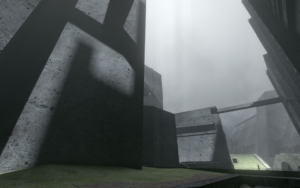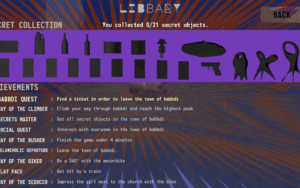From what we know of walking simulators, as described by the assigned article, “A Brief History of the ‘Walking Simulator’“, it hasn’t held much intrigue to the gaming society because the main mission may seem too simple; all you do is just walk and explore.
When thinking about the Formal elements of game boundaries, Babbdi plays around with boundaries of utility. A bat and leaf blower is used as a tool for propulsion. An objective can be achieved by trying something otherwise strange like hitting a barking dog with a an extremely bouncy soccer ball. The game does not go too far in dismantling realism; the balls roll, pigeons fly away when you approach them and bodily functions and limitations like where one can stand, jump, and squat are strictly upheld. But the procedures of the game are so carefully constructed to push against boundaries of logical thinking that it creates a type of fun that centers discovery not just spatially but discovery through resourcefulness and curiosity (think: ‘what can this flashlight do for me?’ or ‘what happens if I hit this dog with this ball’?). The game rewards players that can think in such out of the box ways as this type of creativity is what leads you to advancing in the game and making progress on the quests.
In terms of game objectives and outcomes, I also love that Babbdi presents its players with multiple ways to “win”, something that I think might be an understated element of game designs with an aesthetic of discovery. This allows players to not get so focused on navigating the game world for one specific purpose. In Babbdi, in my walking, I could stumble upon something that guides me towards getting a train ticket out of Babbdi (one way to win), but I don’t have to solely focus on that because I can also stumble upon collectibles that progress my status in the game, or stumble upon a new way to propel myself up to reach the peak of Babbdi (another way to win). Having a goal gives the player something to work towards in a walking simulator; having a choice at any time between multiple goals to go after suspends the emphasis on discovery.
Therefore walking tells the story because, as mentioned above, it is the main mechanic used for interaction and discovery that a player can use to “win the game” and the goal of winning does not get in the way of just wandering. With little starting instruction, walking and exploring both spatially and in utility is the only way you learn the world, and by learning the world, you get better at navigating the world. In this way, Babbdi further embeds their narrative of world escape into the game mechanic. Like many systems and spaces in real life, in order to conquer it, you must first understand its unique rules and and governing structures.






